Wildlife, water birds and lakeshore views… camping at Tashinga puts you at the heart of the action in Matusadona National Park. Intrepid self-drivers with a soft spot for the wild and thirst for adventure will adore this mesmerising protected area in Zimbabwe. By Melanie van Zyl
Matusadona National Park is a place of wonder and inspiration situated on the serene shores of Lake Kariba.
Sitting in a comfy camp chair at Tashinga campsite (the park’s main headquarters), you can expect breathtaking views of the surrounding hills, islands, and fantastic wildlife. As I did.
Shaded by a mahogany tree while admiring the silky lake waters after lunch, I was scribbling into my notebook. Every so often I would peep through my binoculars at the birds bouncing in the branches above. Then I got that ‘I’m being watched’ goosebumps feeling. A big bull elephant ambled into view, padding along the shoreline. It slowly meandered between the trees, picking off the best fruits and twigs, leaving me and the other campers in awe.
As the sun dipped lower over the water, the skeletal silhouettes of drowned forests stood out against the moody indigo mountains. From the tent porch I enjoyed an unforgettable panorama. Lights, camera, snap!
The story of Matusadona National Park
Matusadona National Park is a beautiful destination and a renowned example of conservation in action to boot.
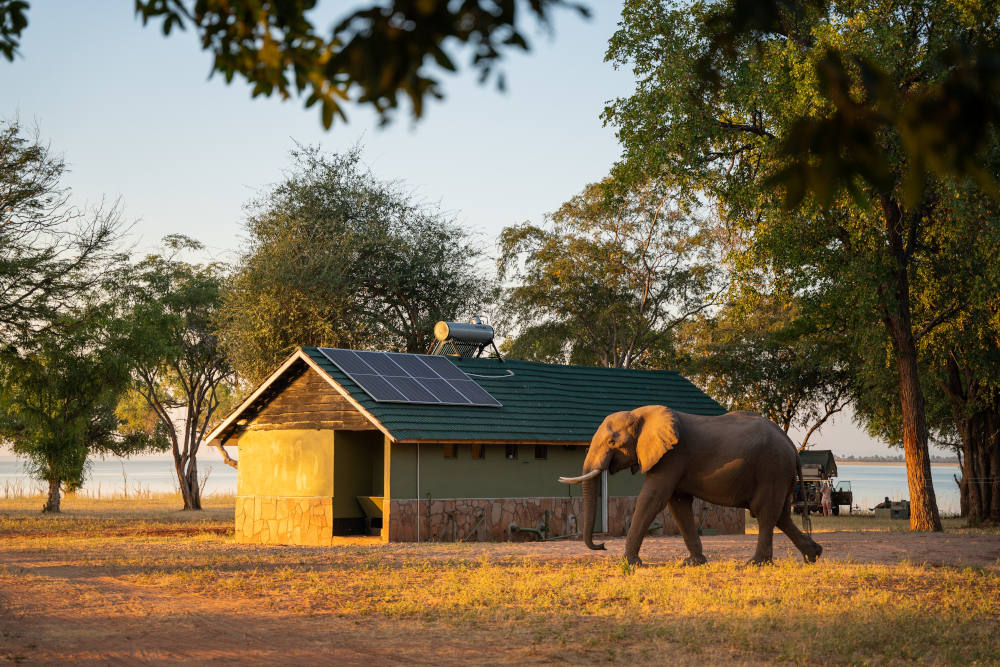
In the late 1950s, the Kariba Dam flooded much of the middle Zambezi Valley, creating Lake Kariba. The valley’s prolific game was concentrated on its islands and southern shore, where Matusadona National Park was created.
During years of political instability in Zimbabwe, the rugged terrain of this region, coupled with limited workforce and financial resources, made it extremely difficult to protect the park. Rampant poaching wiped out several species, including the black rhino population, and severely reduced the elephant population. However, difficulty accessing the park has helped preserve its habitat integrity and prevented agriculture from taking root.
In 2019, the Zimbabwe Parks and Wildlife Management Authority partnered with the African Parks network to form a superhero team. They signed a 20-year agreement and formed the Matusadona Conservation Trust (MCT). This management partnership wants to revitalise the park for wildlife and communities following African Parks’ established methodology. This ensures the park’s long-term future through increased security, improved community relations, and carefully planned wildlife reintroductions.
Why you should visit the shores of Lake Kariba
By supporting Matusadona, you are acting as a guardian of these diverse landscapes and the wildlife that calls it home. At one point, Matusadona National Park supported the highest density of lions in Africa. It was also an incredible stronghold for elephants and black rhinos.
Despite devastating losses, today, the park contains a strong baseline of wildlife species. In addition to elephants, there are lions (several of which are famous for hunting and feeding off crocodiles), buffalo, hippo, waterbuck and impala. Interestingly, studies have revealed that Matusadona is also a vital pangolin area with a thriving wild population. The park supports numerous other interesting species like caracal, serval, water mongoose, porcupines, and honey badgers. Restoring Matusadona’s wildlife populations is a management priority to revive the park as Zimbabwe’s premier elephant and black rhino sanctuary.
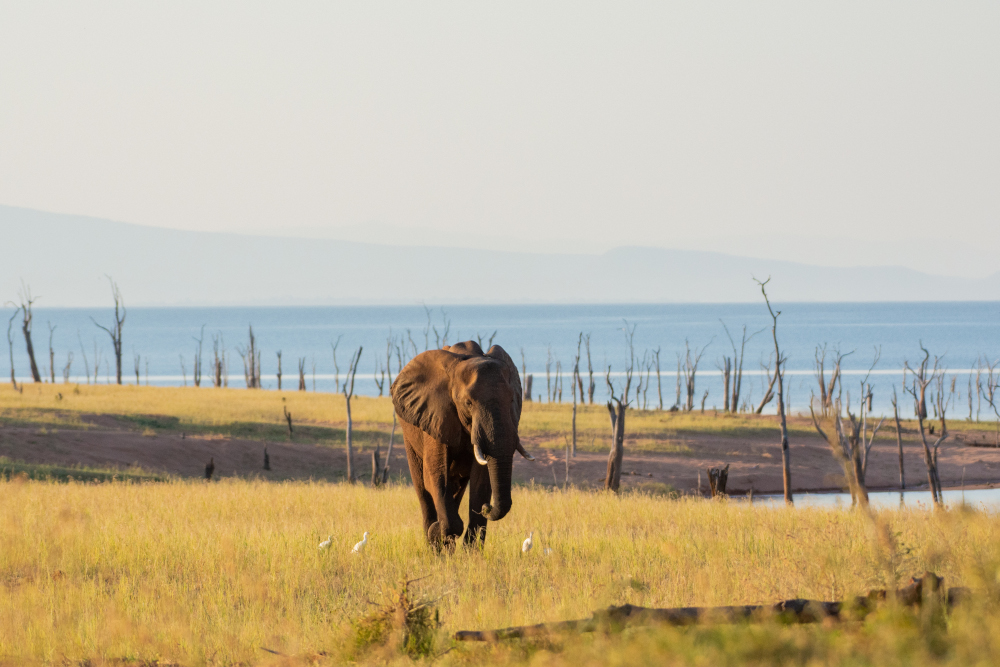
Rich, nutritious grasses growing on the lake banks provide a haven for numerous herbivores. At the same time, the thick mopane and combretum woodlands of the Zambezi Valley floor inland offer refuge for browsers. During game drives, kudu, buffalo herds, warthogs, and waterbucks trot across the landscape.
Based on a study that utilised camera traps, the leopard population here is thriving. The density of these enigmatic cats in Matusadona is among the highest in Zimbabwe, and Africa. The average density of leopards in the park is around 12 animals per 100km2, with the highest concentration in the park’s escarpment. (Notably, the Sabi Sands, renowned for its leopard population, has a similar density).
What to do in Matusadona
The park is a fabulous fishing and boat cruising destination. Bring your rods and land a big one, or enjoy the scenery. On boat cruises, hippos huff, and elephants stroll the stunning lake shores. A survey conducted in 2021 identified over 2,100 hippos along the Matusadona shoreline. This is a significant increase from the approximately 250 hippos present in the early 1980s.
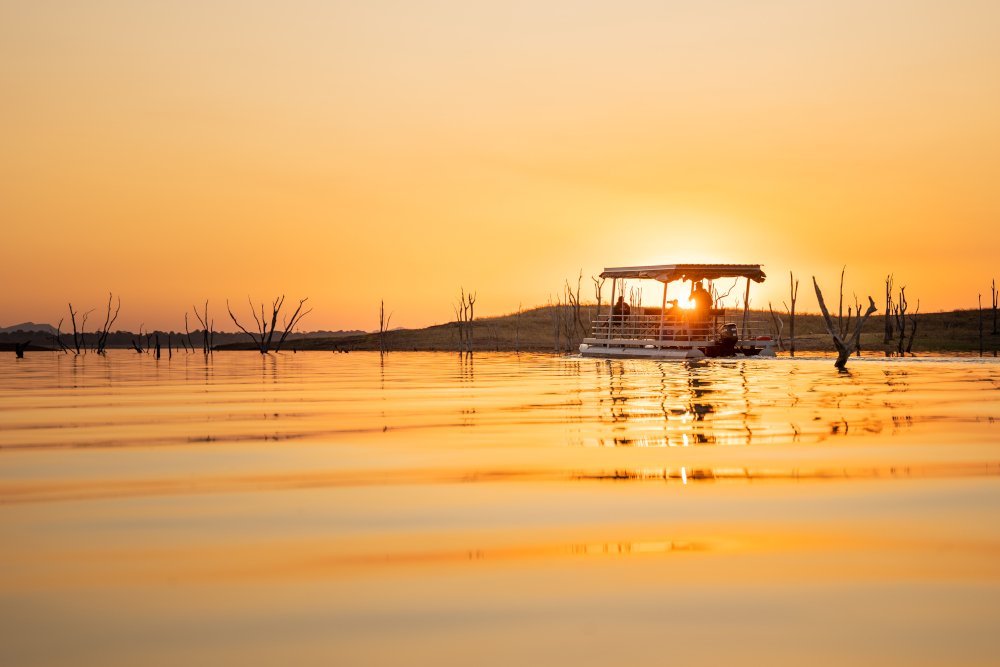
Matusadona is a park that encourages more than one approach to its exploration. Of course, there are the standard open-vehicle game drives, but Zimbabwe is home to some of the best walking guides in Africa! Trained guides lead these safaris, providing insights into the park’s ecology and tracking wildlife.
Matusadona is starting to live up to its phenomenal potential.
Camping at Tashinga
Located on the shores of Lake Kariba at the edge of the Ume River estuary, this campsite has a gorgeous setting. Tashinga has open views across the water that provide a front-row seat for both sunrise and sunset.
A community of stately shade-throwing trees shelter many sites. Elephants and impalas regularly wander through the grounds, adding to the sense of adventure and wonder.
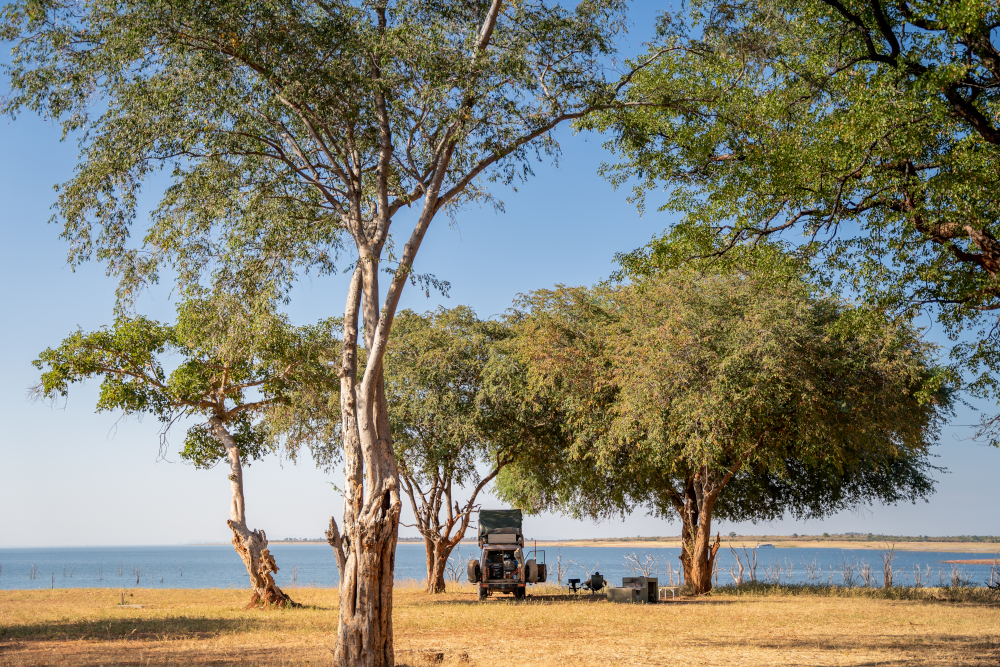
At night, you will witness the soft glow of lamp-lit rigs fishing for kapenta. Don’t go walking alone at night! It’s advisable to rather drive to the ablutions.
Under new management by African Parks since 2019, the park recently renovated the ablutions. Expect flushing toilets, washbasins and showers with hot and cold water. The bathrooms are equipped with solar power and are fully supplied with loo roll, hand soap,and paper towels. Firewood and braai facilities are available.
There is also the opportunity to try glamping. You can arrive at a camp set up for you. The team can rig large East African-style walk-in tents fully equipped with proper beds, crisp linens, and duvets. There is even the option to have dining tents set up and to hire camp staff to prepare meals, do laundry and keep the camp running whilst you enjoy the park.
Good to know
Getting there
There are two full-time road crews with graders, backhoe loaders and tractors hard at work rehabilitating the park roads. The result is that the road network is in pretty good shape these days. However, the two main approach roads do require a reliable 4×4 vehicle with high clearance.
The first access route is by ferry across the lake from Kariba town, which can be expensive. However, African Parks is buying its own ferry, which should be affordable, reliable, and in place during the course of 2024.
Route two is over the Ume on the African Parks ferry. Cutting through the community areas to the west of the Park, this option offers insight into rural Zimbabwe life as you go through some very remote and traditional village areas, notably Mola village.
Option three is to cut through the escarpment from Chifudze – the road has been redone and the team will continue to improve it every year. It is a dramatic and beautiful route into Matusadona, but you need to take your time.
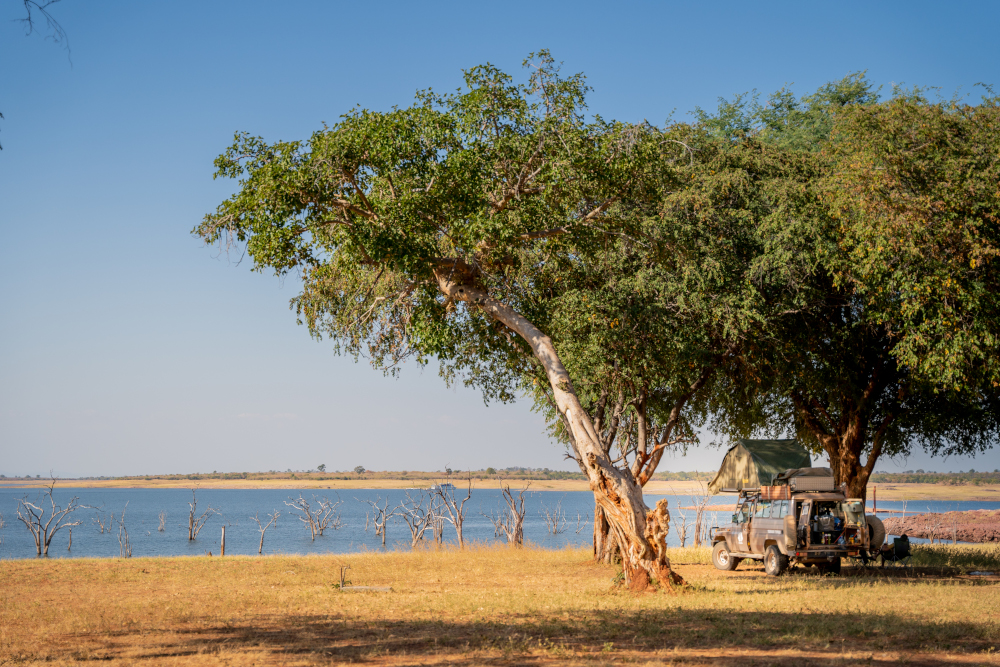
The park team is also considering opening a fourth route through the rugged and remote escarpment wilderness area. Currently, this route is only used by Law Enforcement teams, and the road is very rough. But the hope is to have it in working order in 2024. If you are driving in from the Harare / Karoi side, you will turn into the park about 35km short of the current turnoff. You will be able to access some incredible wilderness campsites in the escarpment area before descending onto the valley floor. The route follows a dramatic road over the lip of the escarpment.
Accommodation
In addition to the main Tashinga campsite, there are also more remote wilderness campsites, like Jenje Bush Camp, in wilder areas of the park.
Six new tented chalets are also currently being built near Tashinga campsite. A few old Tashinga rhino boma poles have been dusted off and carefully staked into the ground as foundations are poured. Canvas sides protect a wood-panelled en-suite bathroom and a spacious bedroom. There is a detached private kitchen and braai area a few metres away. The old, worn, and weathered rhino boma poles are the trusses for what will become a veranda with unbeatable views over the Bumi Hills Bay.
There are also upmarket safari lodges with swimming pools, boat safaris and recreational fishing, usually accessed via boat transfer from Kariba town.
Costs
- Daily conservation fees: $20pp per day for SADC and $30pp for international visitors.
- Vehicle entry fees: $5 per day for foreign registered 4X4
- Accommodation: Camping from $10pp per day for SADC and $15pp for international visitors. Glamping from $20 per day for a dome tent.
- Game Drives: from $35pp
- Boat Cruises: from $30pp
- Walking Safaris: from $35pp
Activities
Self-drivers will want to explore the park on their own steam, but boat cruises depart in the Tashinga, Ume and Jenje lakeshore areas. Guided game drives and walking safaris are available in the morning and afternoon.
Provisions
You’re best off stocking up before you set out for the park. Bring all you need. The headquarters can provide fuel, and there is a small shop with some basics. But if you can’t do without something, best to bring it along. There is also a carry-in, carry-out policy for rubbish.
Contact
The on-site reservations team now has a dedicated cell phone line. Matusadona is remote and wild; thus, the cell signal is unreliable. However, WhatsApp is always available on +263 78 677 4616. Otherwise email reservations.matusadona@africanparks.org
Want to explore Zimbabwe? Let the newly launched Tracks4Africa Zimbabwe Traveller’s Paper Map guide you. The map covers the entire country on one side and features more detailed maps of top parks on the other. Like all our maps, it shows accurate distance and travelling times based on actual overlanding data.
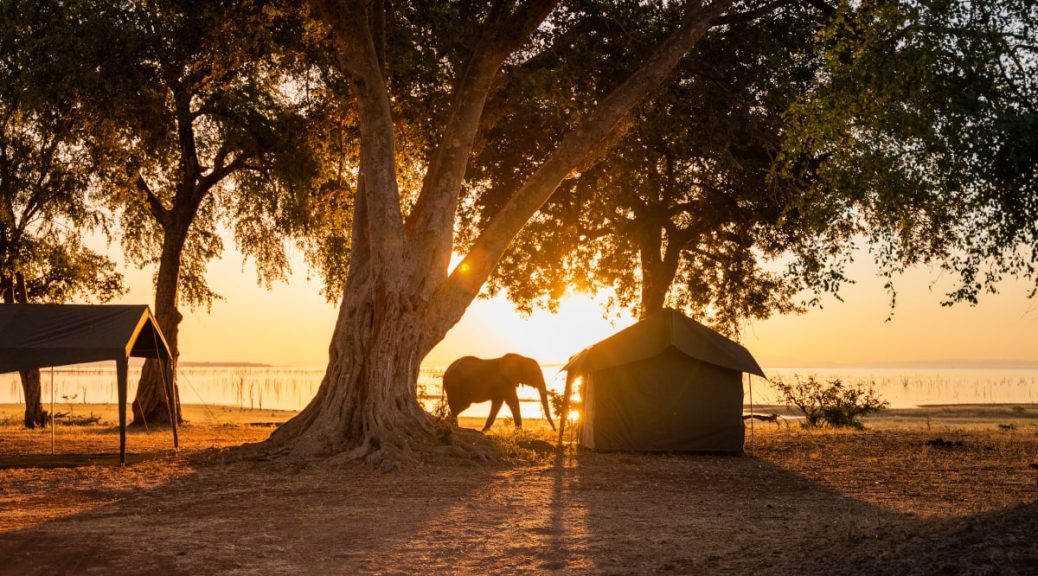

Completely agree! Matusadona National Park is incredible. I have such fond memories from spending my childhood holidays there and on Lake Kariba. It’s amazing to see the wildlife so close up in such a beautiful setting. Highly recommend visiting this magical place. Bumi Hills and Kanga Safari camps are amazing spots to stay at.
#MatusadonaMagic #LakeKaribaMemories
Jeez. I wonder when the Govt. will go further to get private sector to invest in the worlds heritage here in Zimbabwe. Hoping Matopos, the world Hertige Site, will be the next to show vast improvement from the abysmal management presently seen.
We visited Matusadona and Tashinga in November 2023 and had two marvelous and relaxing days there. The ablutions are the best we had seen on our 3 month trip, the friendliness of the staff was exellent. They also did a lot of roadwork to make access more easy. We definitely spend too less time in the park and therefore will come back.
The pictures with the elephant are very nice I think it must be the same we experienced both days.
Good to have this feedback. Great that you also had the elephants visit during your stay at Tashinga!
Not worth the experience for me. Conservation fees are hectic for what you get. There are no Rhino, this time last year, and no cats to be seen. Game is very skittish.
The camping site was very clean and well run, ablutions excellent.
However, I will not be going back again until they lower their costs
Thanks for sharing your experience with other big game fans. Animal sightings are best during the dry season (approx. June-October) when wildlife visit the lake. For some travellers, Matusadona’s incredible natural beauty is reason to visit in itself.